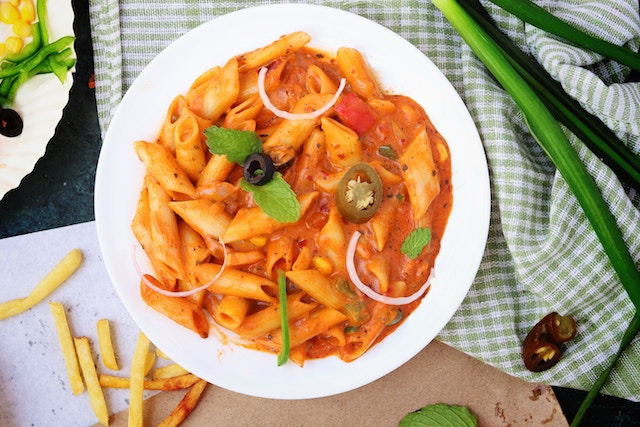A Guide to Food Faux Pas in Italy

Italian is arguably one of the most well-known, beloved global cuisines. The names and preparation of signature dishes have become so commonplace, you don’t have to be a self-declared foodie to rattle off a list at a moment’s notice. However, familiarity comes with a cost which most of us pay for (with interest) on our very first trip to Italy.
Unbeknownst to the typical non-Italian traveller, much of what we know of Italian cuisine is wrong. As with other ethnic foods in Italy, Italian food outside of Italy is “customized” and “hybridized” to suit the tastes of the people it is being served to, which, in North America, can be witnessed in the cheese-pushing in many dishes, as well as the sheer abundance of creamy pasta and salad sauces.
Additionally, most of us, myself included, were never taught the rules to eating Italian-style and consequently, tourist food faux pas are extremely common. So here’s a set of rules and facts that will have you ordering and feasting like you grew up with nonni (Italian for grandparents):
A Guide to Food Faux Pas in Italy
How does an Italian meal work?
Sitting down for a true Italian meal can be like preparing for the apocalypse in regards to the amount of food served, but also in the complexity of the phases. Once you get out of the initial shock, it’s actually quite simple and logical. Here is the order of the courses served: antipasti (like appetizers), primo (first dish, usually pasta or rice), secondo (second dish of meat or fish with contorni/side dishes), frutta (fruit), dolce (dessert), caffè, digestivo (a digestive drink).
Naturally, not every course must be served at every meal, this is just for reference as to what it could look like. Depending on how hungry you are, you could opt for just one of the courses or any reasonable combination such as antipasti and secondo, or primo and secondo.
Just a reminder, wine doesn’t qualify as a course so you can’t have it as a meal by itself. I know, blasphemy.
What do you mean there’s no such thing as fettuccine alfredo?
It might come as a rude awakening, but many classic Italian-American dishes don’t actually exist in Italy. I like to say they were tweaked after crossing the ocean, and fettuccine alfredo is a prime example. Others include Caesar salad (or really any salad with anything other than olive oil and vinegar, including Italian dressing), garlic bread, chicken and veal parmigiana, Italian Wedding Soup, pepperoni pizza…and the list goes on unfortunately.
The fact is, many restaurants now realize that tourists frequently request these dishes and therefore it’s possible to find them in Italy. However, even so, you should consider that these dishes are not authentic and my advice would be to stay away…stay far away…and order something that you can’t pronounce or simply ask the waiter what a piatto tipico (typical dish) might be.
Why the strange looks when I order spaghetti allo scoglio in Milan?
In Italy, it’s best to order dishes that are typical of the region (ex: Lombardy, Tuscany, Emilia Romagna are all regions of Italy). Ordering spaghetti allo scoglio (a seafood pasta) in Milan would be like ordering catfish and hush puppies in the mountains in Colorado, not a complete travesty but you’d probably have been better off with a local specialty. Same goes for Italy, so do your research.
Order seafood dishes where you can see the sea from your table, risotto alla milanese when in Milan, and bucatini all’amatriciana when in Rome. Certainly there’s no problem if every now and then, you have an intense craving for a dish that is not typical of the region you’re in. I just wouldn’t make it a habit.
And now for a random assortment of “rules” (in no particular order):
- Do not put cheese on fish dishes or on seafood pasta.
- Typically, you choose your meal to be either land-based or sea-based, there’s none of this “surf-and-turf” in Italy.
- No ordering a cappuccino after mid-day, it’s a breakfast drink.
- Absolutely no cappuccino after meals, dairy impedes digestion.
- Don’t ask for pineapple on pizza, Hawaiian pizza is not exactly highly regarded because Italians aren’t into mixing sweety and salty flavours.
- Stop dipping your bread in oil and balsamic vinegar, it’s to complement your meal or to use as a “scarpetta” (a little shoe) to mop up any leftover sauces.
- Cocktails are for aperitivo hour or to drink at the bar with your friends, they are not to be accompanying beverages to your lunch or dinner. Wine, beer, or water are your options.
- If you must have a pepperoni pizza, ask for a diavola or for it to be topped with salame piccante.
- Serious gelato-folks won’t trust you if you ask to mix a cream flavour (ex: fior di latte) with a fruit-based gelato (ex: limone).
- Bruschetta is pronounced “broo-skeh-ttah”, the “ch” in Italian is not pronounced like in English.
- Just say no to butter, it does not go on bread in Italy.
- You can have soda (or beer) with pizza only, it’s one of the rare times that soda is “allowed” with a meal in the sense that no one will judge you or think you’re a kid.
Personally, my biggest food mistake in Italy was probably having Coke with my non-pizza meals. It used to give my boyfriend a heart attack since the thought here is that these sugary drinks take away from the taste experience of the food. Funny, now that I’ve lost this habit, I couldn’t possibly imagine having a soda while eating!
That’s it for now folks! Let me know if you agree or disagree with any of these points or if you’ve ever been caught in a faux pas moment while in Italy!
A Guide to Food Faux Pas in Italy
Related Reading
- 10 Things You Want to do Before Traveling to Italy
- Travel Itinerary: A Taste of Italy in 12 Days
- How a Visit to Pompeii Transformed My Travel Philosophy for Life
- A Ferrante Guide to Naples
- Why You’ll Want to Visit Florence in the Off-Season
- How One Night in Milan Proved that Solo Travel is Awesome
- Conquering Travel Fears, One Gelato at a Time
- Finding Hidden Gems in Murano, the Glass Island of Venice
- Savouring the Towns of Tuscany, Italy
- Choosing to Do One Thing Everyday That Scares Me in Italy
Do you have tips for women travelers in Italy? What were your impressions? Email us at editor@pinkpangea.com for information about sharing your experience and advice with the Pink Pangea community. We can’t wait to hear from you.
A Guide to Food Faux Pas in Italy photo credit unsplash.com.









Hi Rachel, I really enjoyed your article, and believe me it catches the entire essence of the Italian cuisine culture!!!!
I forgot how many time I told ppl how to pronounce BrusCHEtta 🙂
When I run my meet up groups I explain how important is for Italian the respect the traditional dishes. We don’t like miss pronounces or alterations on what is traditional and historical; yes, because believe me many of our dishes as the “Bucatini alla Amatriciana ” or “Risotto alla Milanese” are recipes created during the “Roman Empire” and we are still carrying them with lots of proud 🙂
I like to add one more tradition to your story which is the “Aperitivo” . Beside the drink itself, the Aperitivo time has a tradition created in Milan which is to accompany food during this happy hours. All the bars created cold and hot dishes offered to guests for free with the purchase of a drink, Fun right? This is for some a light diner for others a happy hour after work!
I like to share with you and your followers a couple of link.
My meet up group: http://www.meetup.com/I-LOVE-ITALIAN-FOOD/
My Video Recipe of Spaghetti with Vongole : https://askcheftony.wordpress.com/2015/03/12/somewhere-beyond-the-sea-guest-post-by-francesca/
I hope you”ll enjoy it 🙂 ciao!!!!